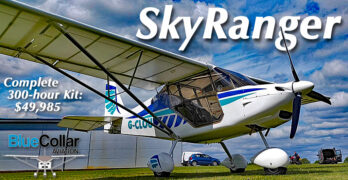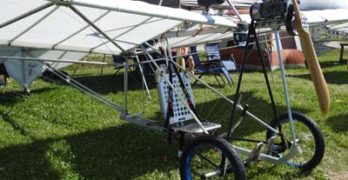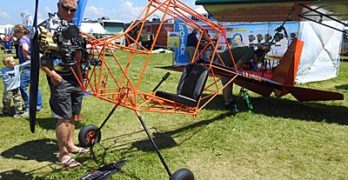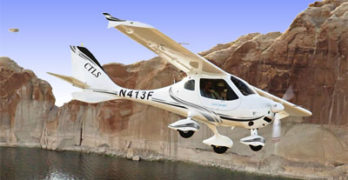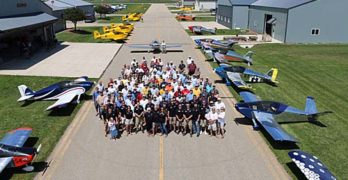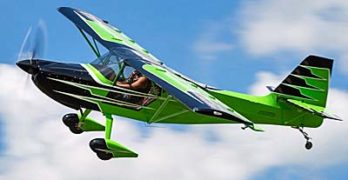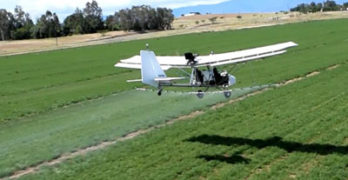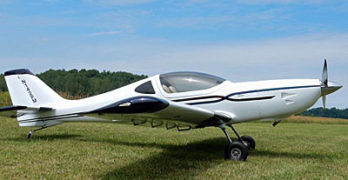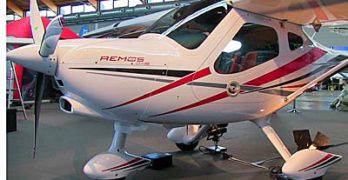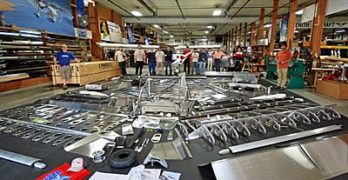Tabor Coates calls his business Blue Collar Aviation. Honestly, as someone who scours the globe for affordable aircraft, any business with this name was certain to grab my attention.
This isn’t simply adroit marketing. Tabor’s Maynard, Massachusetts operation is deep into affordable aviation. How affordable? Tabor’s most-expensive offering is the SkyRanger Nynja (featured in this 2023 article and this flight report). With every item needed in the kit to include engine, instruments and coverings that need no paint, this tried-and-true light aircraft sells for $65,000 and that even includes freight from across the Atlantic.*
How deep into affordable goes Tabor? He offers two versions of SkyRanger — Swift III and Nynja — with a complete kit for the former starting at $49,985. If that’s still high for your budget Tabor offers FlyLight’s line of superlight (nanolight?) weight-shift trikes. The simplest of these flying machines are ready-to-fly for around $15,000.
Skonkwerks …an Ultralight Aircraft Tribute to an Aviation Pioneer
Update 8/17/17: See our video interview at EAA AirVenture Oshkosh 2017 on this aircraft (at bottom). —DJ
The aircraft you see in the photos is called “A Tribute to Alberto Santos Dumont.” Do you know who that is?
In my conversations with a few other pilots, almost everyone knew the name (“vaguely”) but not one remembered what that person did. Since the 24 Bis (that’s what they call the example you see in the images) is a tribute to Alberto, let’s take a second to recall his history.
Santos Dumont was a prolific aircraft designer working from 1898 to 1920. The first year was when he made his first balloon ascension, in Paris, on July 4th. Only six years later, not even three years after the Wright Brothers’ famous Kitty Hawk flight, Alberto flew his 14 Bis on November 12th, 1906. This flight won him the accolade “first person to fly in Europe.”
His first production aircraft weighed in at 242 pounds.
Big to Small, Just Aircraft Pleases; Now, Check Out their Part 103 Ultralight Aircraft
If you know the Part 103 category of the FAA regulations, you know these are the lightest aircraft in aviation (that is, man-carrying aircraft; drones excepted).* After years of disappearing, Part 103 entries have come back more recently and at AirVenture Oshkosh 2017, we saw another.
This is the Just Aircraft Superlite, except that name was never certain and has (since Oshkosh) been taken off the list as a model name. Until they put a fresh name on it, I will call it Just 103.
Part 103, as most readers may know, requires no pilot certificate (really, none!). They also require no FAA registration or N-numbers. Since 1982, you need no aviation medical to fly one. Plus, they can be built ready-to-fly… or in kit form of any percentage. For 35 years now — the rule went effective in September of 1982 — Part 103 ultralight vehicles have been part of the aviation firmament.
Update: Flight Design and its Popular CTLS Light-Sport Aircraft
After more than a year, a resolution was reached for the airplane that topped the charts in the LSA space since Day One. Although Flight Design’s CT-series was eclipsed in 2016 by CubCrafters (by a very slim margin), the aircraft remains well regarded and its many adherents are no doubt breathing a sigh of relief that the “reorganization” (what Americans might call a bankruptcy) has been resolved. All good!
(Read more about this reorganization here.)
During EAA AirVenture Oshkosh 2017, longtime Flight Design USA representative Tom Peghiny sent news about the new owner of the brand. The crush of airshow activity let others beat us to this news, however, we will use our long history with this company to provide a more detailed report.
That Was Then
Flight Design, the German company that makes the CTLS, has been through the wringer in recent years with a series of reversals no one could have anticipated.
Sonex Homecoming 2017 and Lots of New Products for Kit Aircraft Builders
If you seek affordable aircraft (like most readers), then you already know Sonex Aircraft. If you have somehow missed this iconic brand, you are in for a treat. Great planes, nice people, and more enthusiasm than an airshow crowd watching an aerobatic performance.
The only light aircraft producer based right at the home field of EAA AirVenture Oshkosh, Sonex parlays their co-location with the big event to good advantage.
Sonex will again hold its Open House and Homecoming Fly-In the day before EAA AirVenture Oshkosh on Sunday, July 23rd, at their factory headquarters on the east side of Wittman Regional Airport. “Our 2017 event marks the 14th annual gathering for customer-built aircraft at the Sonex facility,” noted the company in a pre-show announcement. “The event runs from 10:00 AM to 2:00 PM and concludes with a mass taxi ‘arrival’ of customer and factory aircraft across Wittman field to AirVenture grounds (photo).”
This year’s Homecoming Fly-In will feature the first customer-built SubSonex Personal Jet in-attendance, as builder John Corneal will be bringing his SubSonex to AirVenture from Petersburg, Pennsylvania.
Kitfox Is Bringing 2017 Speedster to EAA AirVenture
One of the stalwarts of the light aircraft sector is Kitfox, a brand known widely around the globe. First flown in November 1984 by Dan Denney, nearly 5,000 aircraft in various models have been produced. Nearly all were built from kits but the company also achieved Special Light-Sport Aircraft status allowing flight instruction for compensation.
Kitfox, like all that appear somewhat similar, evolved from the original Avid Flyer by Dean Wilson in 1983. The Kitfox brand went through various owners after Denney sold and today resides with John McBean though the company has always hailed from Idaho.
“Working from the very successful and robust Kitfox S7 Super Sport, we created a clipped wing, aerodynamically refined, and superbly stylized taildragger Speedster that is guaranteed to get the heart rate up to redline,” said McBean in news announced just before Airventure 2017 is set to begin (next Monday, July 25th).
Workhorse Dragonfly Rancher Takes on Heavier Duties — Aerial Work LSA?
You may not know this Dragonfly airplane but I do. Very well. Since before it was called Dragonfly, I followed the development of this unusual aircraft by Bobby Bailey. You probably don’t know him either but he’s one of the most inventive light aircraft designers. A man of very few words, he prefers to create than to talk about it.
Dragonfly is an important icon in the hang gliding community. This aircraft was purpose-built to tow hang gliders aloft. At a place near Sun ‘n Fun called Wallaby Ranch, this happens nearly every day of the year. Proprietor Malcolm Jones founded “the Ranch” in 1992. He has a fleet of Dragonflys that he uses to tow up experts, students learning to fly, or almost anyone wanting to get an introduction to hang gliding.
Dragonfly has been fantastically productive, towing so many thousands of flights that I doubt they could be accurately counted.
Sexy Arion Lightning Taildragger; a Beautifully-Done Homebuilder Project
I readily admit I find Arion’s Lightning LS-1 (the Special LSA model designation) one of the most handsome in the Light-Sport fleet …which is saying something as we enjoy dozens and dozens of quite beautiful aircraft in this sector. It’s also all-American, referencing its design and manufacturing.
Lightning lives up to its name, running easily to the 120-knot maximum for LSA, especially when powered with a very muscular six-cylinder, 120 horsepower Jabiru 3300 powerplant.
Every Lightning to date has been a tricycle gear airplane and, honestly, for most pilots, that is the right choice. However, like many aviators, I love the look of a tail dragger so when I stumbled across the one you see in the photos, I did a double take. Whoa! That looks hot!
What you see here is a product of seven years of work by builder/owner Mike Lotz. I asked him to tell me about it and he offered enough that I’m going to let him tell his story.
Remos is Back and Scores at Aero 2016
Think back far enough in the still-fairly-new LSA sector and you should recall a time when one brand made some major impact on all of personal aviation. The company was Remos and their U.S. team amped up promotional activity to the level of full page ads in most of the biggest aviation magazines in aviation. By my casual estimate, Remos was spending north of $35,000 per month on splashy advertisements.
Remos also did an airplane giveaway with AOPA; the company was a seemingly unstoppable juggernaut. Prudent or not, you had to admire that the company pulled out the stops in an effort to become the main LSA brand. Such a no-holds-barred approach has worked for products in other industries. However…
Then the door of opportunity slammed shut. It was not that the advertising didn’t work. Certainly it did make the brand well recognized. However, by 2009 the global economy was in a tailspin.
Cruzer Prepared for FAA Kit Evaluation Team
Even very familiar companies like Zenith Aircraft company, part of a family light aviation empire including Zenair in Canada•, has to prepare well when FAA comes to visit. Specifically, this would be the agency’s KET or Kit Evaluation Team. When various representatives of the regulatory agency visit they use a multi-page list to assure that a kit aircraft meets the requirement that 51% of the kit is built by the owner.
Formerly called Experimental Amateur Built (or EAB), many aviators simply say the “51% rule.” In earlier times, kit aircraft were scratch built — meaning a builder secured raw materials that had to be formed and finished while referring to drawings, a potentially very lengthy process. To ease the effort and increase sales, an industry developed to sell component kits. These have become increasingly sophisticated with qualities such as match-hole construction using CNC machines.
Making it easier for a builder to assemble his or her aircraft is good, but the kit manufacturer must be able to clearly demonstrate how the owner will do 51% of the work, as required.
- 1
- 2
- 3
- …
- 52
- Next Page »


